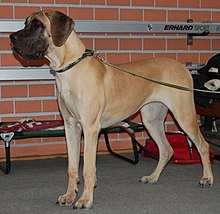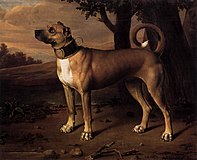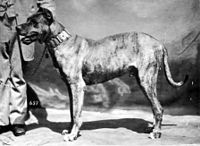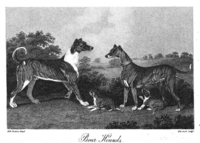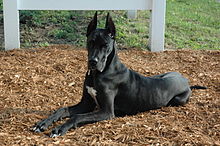
The Azawakh is a breed of dog from West Africa. With ancient origins, it is raised throughout the Sahelian zone of Mali, Niger, and Burkina Faso. This region includes the Azawagh Valley for which the breed is named. While commonly associated with the nomadic Tuareg people, the dogs are also bred and owned by other ethnic groups, such as the Peulh, Bella, and Hausa. The Azawakh is more related to the Sloughi than it is to the Saluki.

The whippet is a British breed of medium-sized dog, of the sighthound type, related to the larger greyhound and the smaller Italian greyhound. Apart from the differences in height, the whippet closely resembles these two breeds; it has sometimes been described as "the poor man's greyhound". It is kept as a companion dog, for competitive showing, for amateur racing as well as lure coursing. It has the highest running-speed of any breed in its weight and size range, and may have the fastest idle-to-running acceleration of any dog.

The Catahoula Leopard Dog is an American dog breed named after Catahoula Parish, Louisiana. It became the state dog of Louisiana in 1979. It is recognized by the United Kennel Club under the name Louisiana Catahoula Leopard Dog, while the American Kennel Club Foundation Stock Service calls it Catahoula Leopard Dog. Both registries have assigned the breed a herding designation, although it has traditionally been used in hunting feral boars.

The Rhodesian Ridgeback is a large dog breed originally bred in Southern Africa. The original breed standard was drafted by F.R. Barnes, in Bulawayo, Southern Rhodesia, in 1922, and approved by the South African Kennel Union in 1927. Its forebears can be traced to the semi-domesticated ridged hunting and guardian dogs of the Khoikhoi. These were interbred with European dogs by the early colonists of the Cape Colony for assisting in the hunting of lions.

The Bullmastiff is an English breed of dog of mastiff type and large size, with a solid build and a short muzzle. It was developed as a guard dog in the nineteenth century by cross-breeding the English Mastiff with the now-extinct Old English Bulldog. It was recognised as a breed by The Kennel Club in 1924.

The Boxer is a medium to large, short-haired dog breed of mastiff-type, developed in Germany. The coat is smooth and tight-fitting; colors are fawn, brindled, or white, with or without white markings. Boxers are brachycephalic, have a square muzzle, mandibular prognathism, very strong jaws, and a powerful bite ideal for hanging on to large prey. The Boxer was bred from the Old English Bulldog and the now extinct Bullenbeisser, which became extinct by crossbreeding rather than by a decadence of the breed. The Boxer is a member of both The Kennel Club and American Kennel Club (AKC) Working Group.

The Affenpinscher is a German breed of small toy dog of Pinscher type. Originally developed as a mouser, the Affenpinscher is now commonly found as a companion worldwide.

The Poodle, called the Pudel in German and the Caniche in French, is a breed of water dog. The breed is divided into four varieties based on size, the Standard Poodle, Medium Poodle, Miniature Poodle and Toy Poodle, although the Medium Poodle is not universally recognised. They have a distinctive thick, curly coat that comes in many colors and patterns, with only solid colors recognized by breed registries. Poodles are active and intelligent, and are particularly able to learn from humans. Poodles tend to live 10–18 years, with smaller varieties tending to live longer than larger ones.
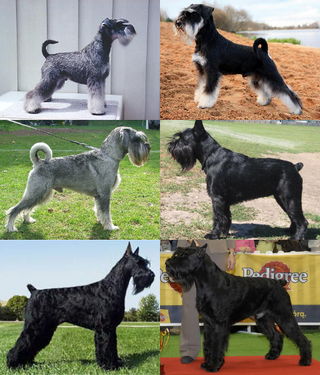
A Schnauzer is a dog breed type that originated in Germany from the 14th to 16th centuries. The term comes from the German word for "snout" and means colloquially "moustache", or "whiskered snout", because of the dog's distinctively bearded snout. Initially it was called Wire-Haired Pinscher, while Schnauzer was adopted in 1879.

The Fila Brasileiro is a Brazilian breed of large working dog of mastiff type.

The Cane Corso is an Italian breed of mastiff. It is usually kept as a companion dog or guard dog; it may also be used to protect livestock. In the past it was used for hunting large game, and also to herd cattle.
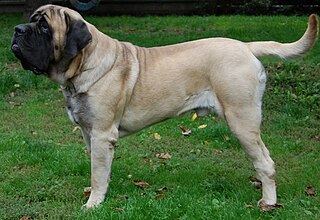
The English Mastiff, or simply the Mastiff, is a British dog breed of very large size. It is likely descended from the ancient Alaunt and Pugnaces Britanniae, with a significant input from the Alpine Mastiff in the 19th century. Distinguished by its enormous size, massive head, short coat in a limited range of colours, and always displaying a black mask, the Mastiff is noted for its gentle and loving nature. The lineage of modern dogs can be traced back to the early 19th century, but the modern type was stabilised in the 1880s and refined since. Following a period of sharp decline, the Mastiff has increased its worldwide popularity. Throughout its history the Mastiff has contributed to the development of a number of dog breeds, some generally known as mastiff-type dogs or, confusingly, just as "mastiffs". It is the largest living canine, outweighing the wolf by up to 50 kg (110 lbs) on average.

The Jagdterrier is a type of working terrier, originating in Germany, that is used for hunting quarry both above and underground. This breed of terrier is also called the German Hunt Terrier.

The Schnauzer or Mittelschnauzer is a German breed of dog in the Pinscher and Schnauzer group. It is characterised by an abundant bristly beard and whiskers, usually lighter than the coat. It is one of three Schnauzer breeds, the others being the Giant Schnauzer or Riesenschnauzer, and the Miniature Schnauzer or Zwergschnauzer. In Germany it is an endangered breed, and is listed in category III of the Rote Liste of the Gesellschaft zur Erhaltung alter und gefährdeter Haustierrassen.

Merle is a genetic pattern in a dog's coat and alleles of the PMEL gene. It results in different colors and patterns and can affect any coats. The allele creates mottled patches of color in a solid or piebald coat, blue or odd-colored eyes, and can affect skin pigment as well. Two types of colored patches generally appear in a merle coat: brown/liver and black. Associated breeds include Carea Leonés, Australian Shepherds and Catahoula Leopard Dogs. Health issues are more typical and more severe when two merle-patterned dogs are bred together.

The Dogo Argentino is an Argentine breed of large dog of mastiff type. It was bred in the early twentieth century in Córdoba in central Argentina, primarily for hunting large game such as peccaries, wild boar and pumas. The foundation stock included the now extinct Córdoba fighting dog, a fighting dog of bulldog type, a Bull Terrier and a Mastín del Pirineo.

The Dutch Shepherd is a herding dog of Dutch origin. They were used by shepherds and farmers who needed a versatile dog, with few demands, and a dog that was able to adapt to a harsh and meager existence.

The Plott Hound is a large scent hound, originally bred for hunting bears. In 1989, the North Carolina General Assembly designated the Plott Hound as the official State Dog. The Plott Hound was first registered with the United Kennel Club in 1946. Plott Hounds were recognized by the American Kennel Club in 2006 and were exhibited at the Westminster Show in 2008.

The Dalmatian is a breed of dog with a white coat marked with dark-coloured spots. Originally bred as a hunting dog, it was also used as a carriage dog in its early days. The origins of this breed can be traced back to present-day Croatia and its historical region of Dalmatia. It is thought that early ancestors of the breed were certain breeds of pointers and a spotted Great Dane. Today, it is a popular pet and many enthusiasts enter Dalmatians into kennel club competitions.

The Grand Anglo-Français Blanc et Noir translated into English as the Great Anglo-French White and Black Hound, is a breed of dog used in hunting as a scenthound, usually in packs. It is one of the Anglo-French hound breeds which were created by crossing French scenthounds with English (Anglo) Foxhounds.
